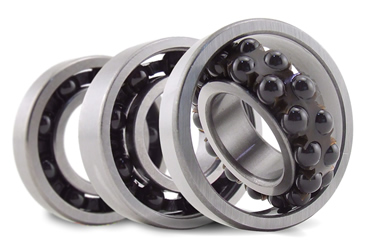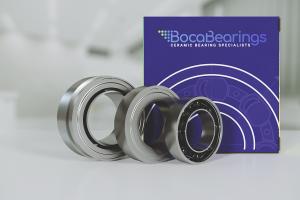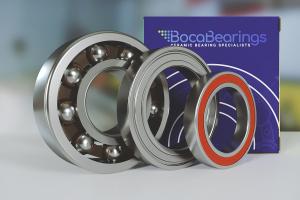Ceramic Hybrid Bearings

Ceramic Hybrid Bearings have Steel races and Ceramic Balls. Ceramic Balls are suitable for applications where high loads, high speeds and extreme temperatures are factors. Long life and the need for minimal lubrication make this material appropriate for extreme applications. Ceramic is non-porous, non-magnetic, non corrosive and lighter than steel. In ball form, ceramic balls are also harder than steel and because ceramic balls are non-porous they are virtually frictionless and capable of spinning faster than steel balls.
Ceramic Balls are usually made of following materials:
- Silicon Nitride (SiN4)
- Alumina Oxide (Al2O3)
- Zirconia Oxide (ZrO2)
- Silicon Carbide (SiC)
Because ceramic is a glass like surface it has an extremely low coefficient of friction and is ideal for applications seeking to reduce friction. Ceramic balls require less lubrication and have a greater hardness than steel balls which will contribute to increased bearing life. Thermal properties are better than steel balls resulting in less heat generation at high speeds.
Ceramic Hybrid Bearing Benefits
- High loads, high speeds and extreme temperatures are factors
- Increased bearing life and decreased down time
- Minimal need for lubrication
- No cold welding between ceramic balls and races
- Multi-purpose use in variety of machines and different production lines
- High efficiency, low weight and small size
Ceramic Hybrid Bearing Applications
Ceramic hybrid bearings are widely used in electric motors, aerospace applications, performance racing vehicles, laboratory equipment, under water applications and more. Any application that requires higher speeds, lower friction and longer life are ideal for ceramic hybrid bearings.
Ceramic Hybrid Bearing Styles and Sizes
Ceramic hybrid bearings are available in variety of sizes and styles:
Ceramic Bearing Articles & Resources
Full Ceramic Bearings Play Hardball
Ceramic Bearing Properties & Characteristics
Ceramic Bearing vs. Steel Bearing Material Comparison Chart
Boca Bearings Engineering Guide




